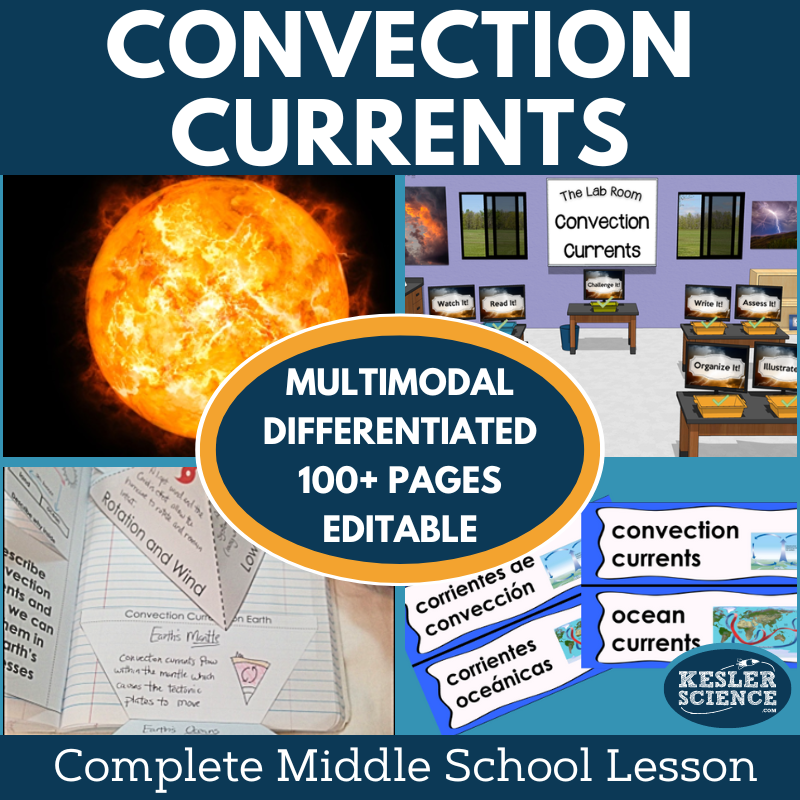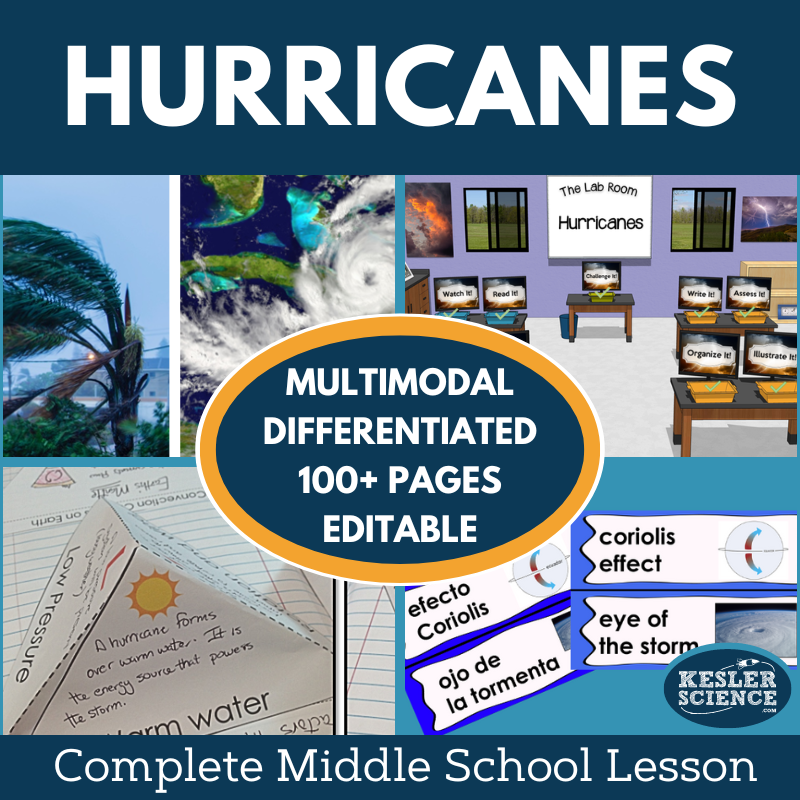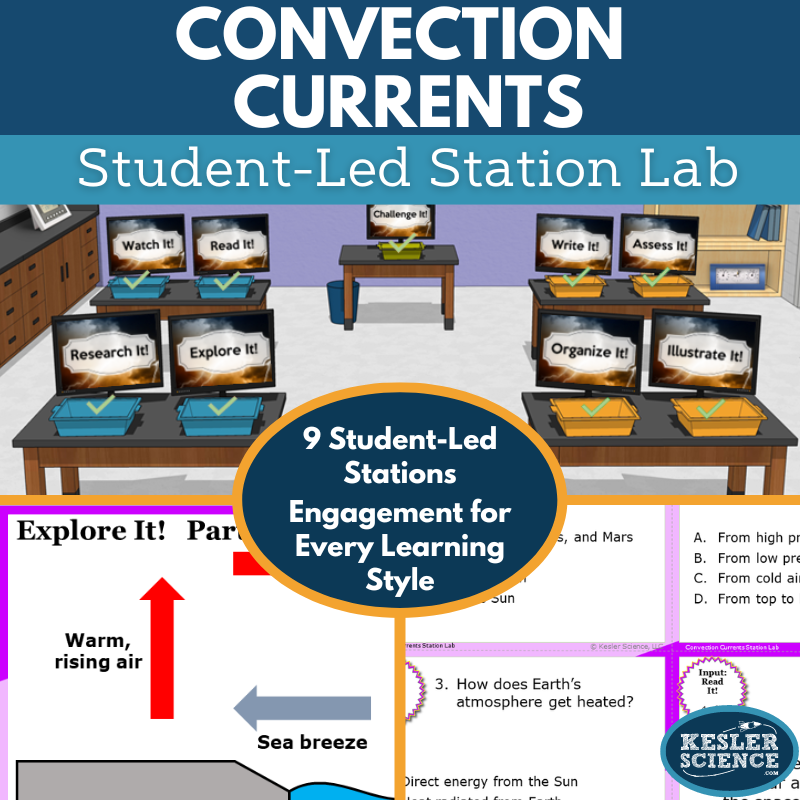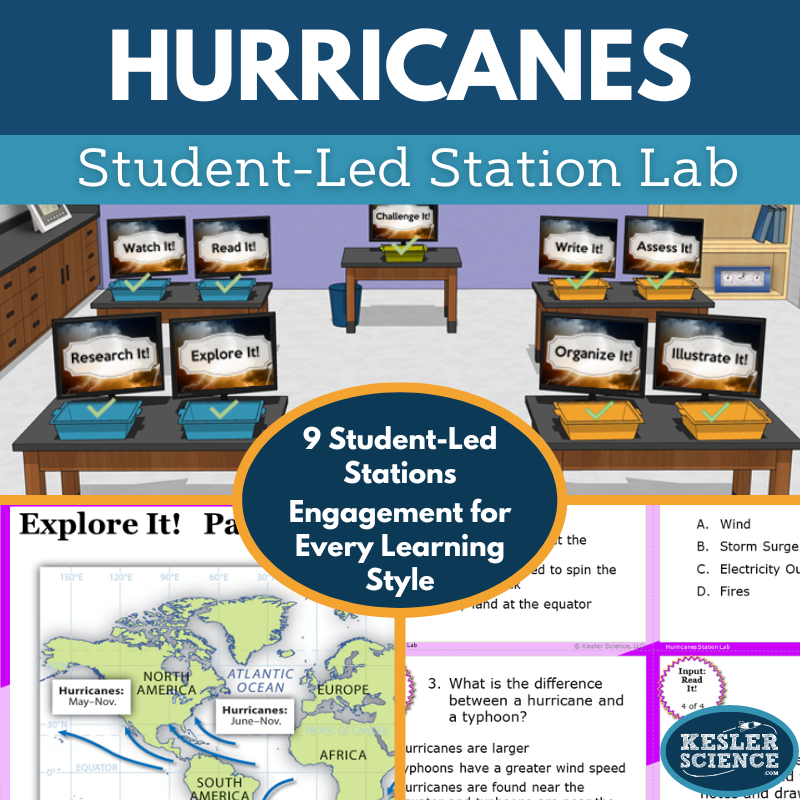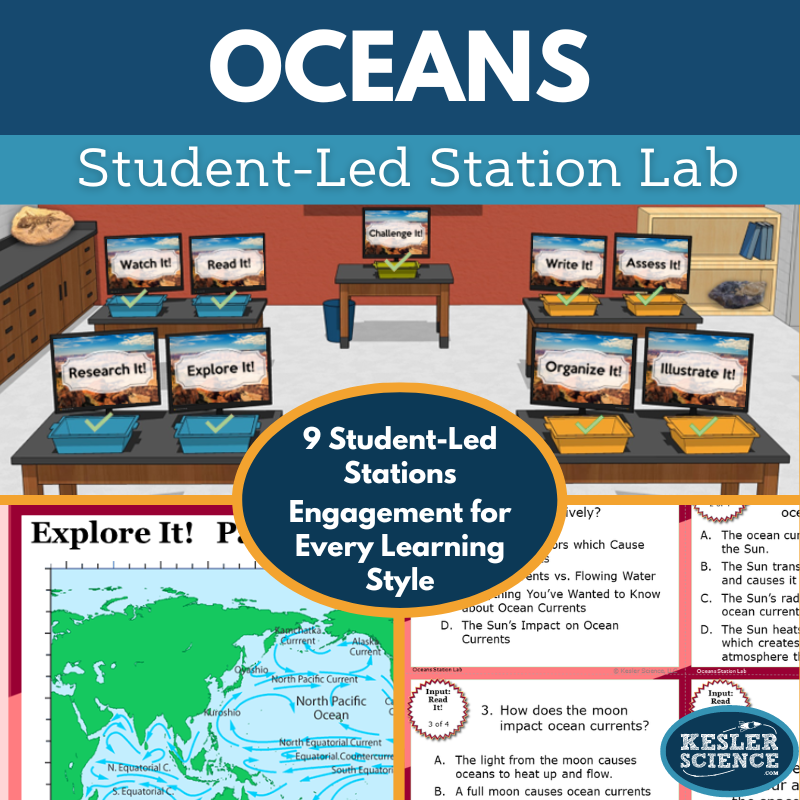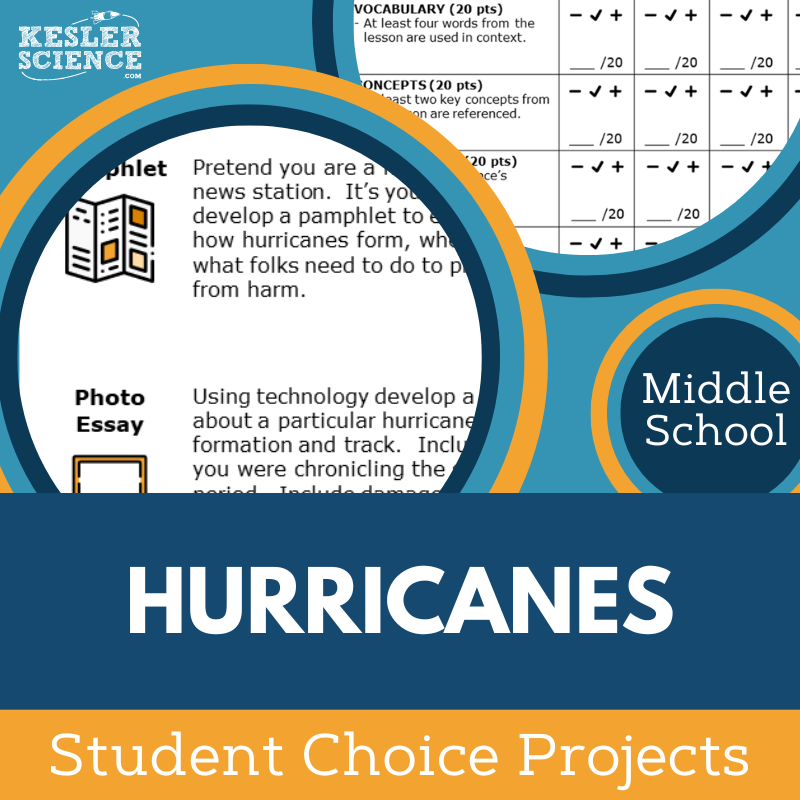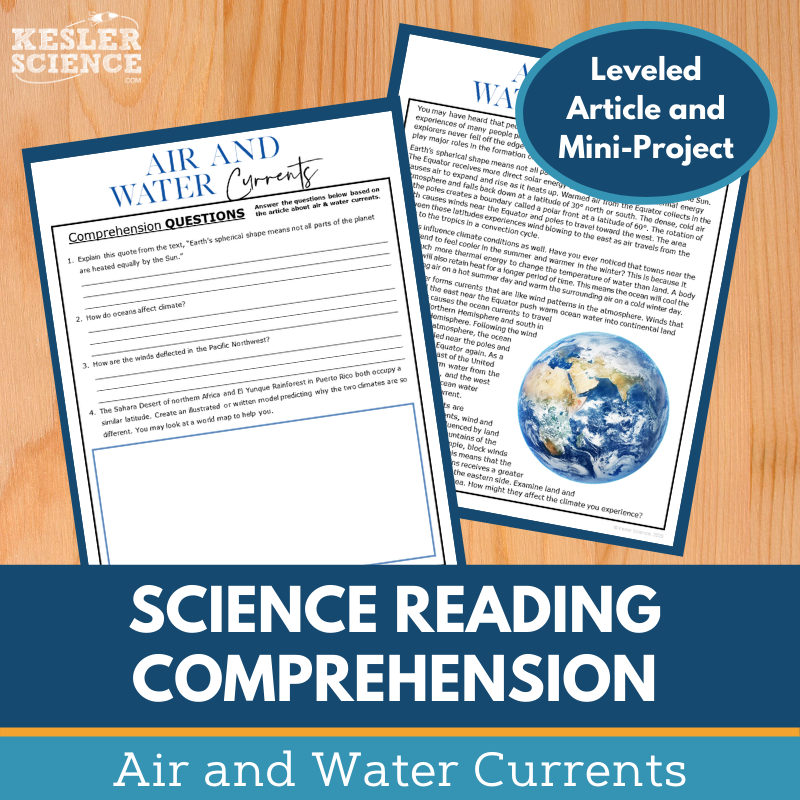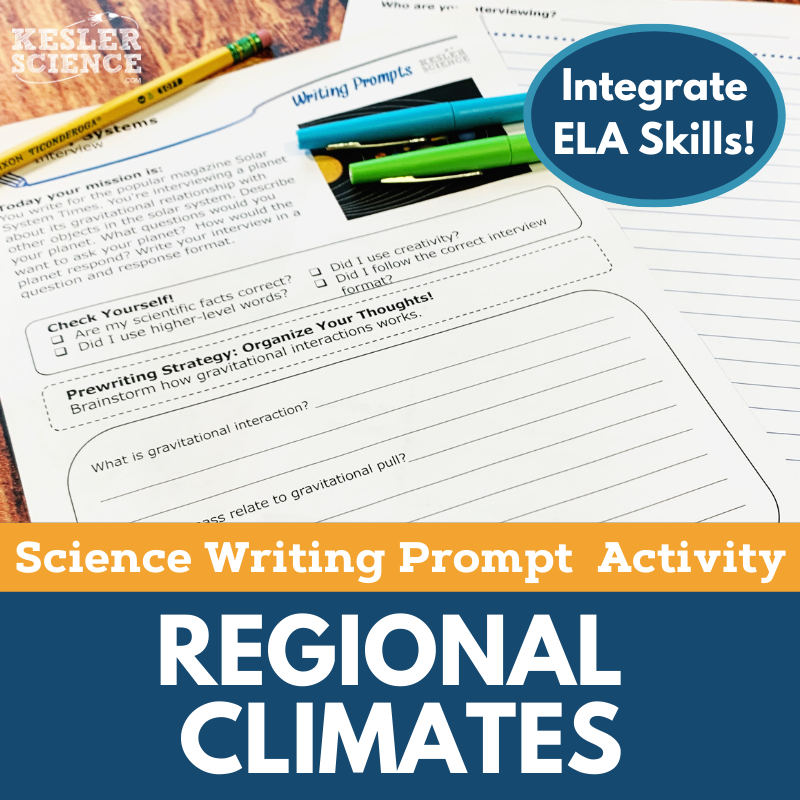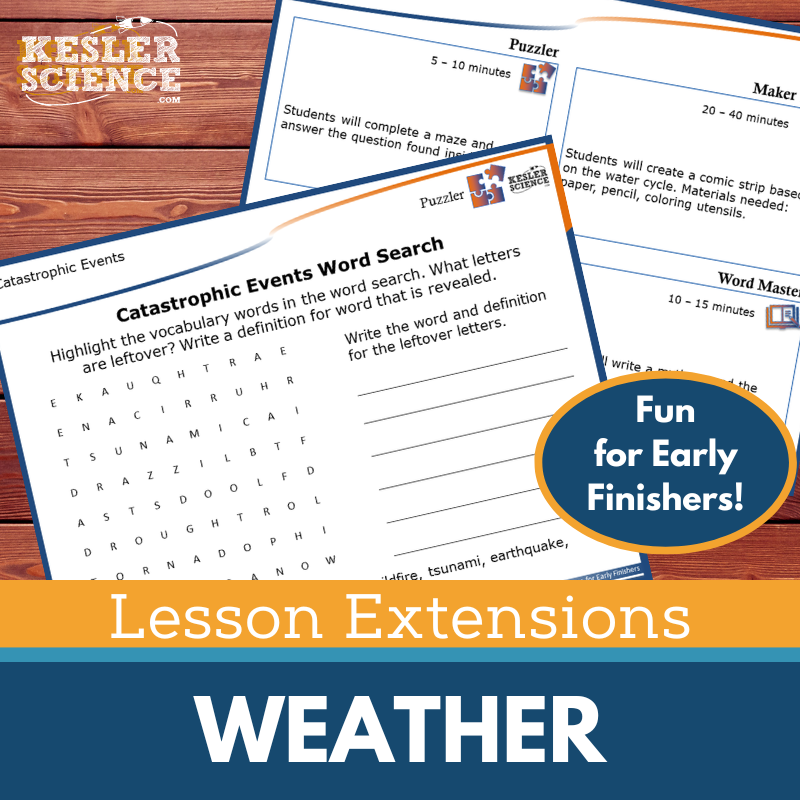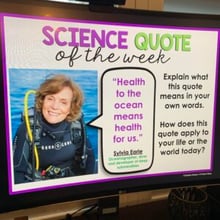Unequal Heating of Earth Activities for Middle School Science
The Kesler Science Convection Currents, Hurricane Formation and Tracking, and Oceans 5E Lessons provide engaging, student-led middle school science units aligned with NGSS and TEKS standards. The resources below will give students a comprehensive understanding of the unequal heating of Earth. All of the following materials are also included in the Kesler Science Membership.
The Kesler Science Convection Currents 5E Lesson is a comprehensive middle school unit exploring how the Sun’s energy drives convection within the atmosphere and oceans, producing winds and ocean currents. This fully editable, student-led lesson includes presentations, worksheets, choice projects, and assessments, requiring minimal prep while promoting differentiated learning.
Following the 5E Model, the lesson engages students with vocabulary cards and class discussions, then guides them through a student-led station lab with nine differentiated exploration stations. These stations include hands-on experiments, reading passages in English and Spanish, research tasks, videos, and various output activities like writing, illustrating, and assessments. A bonus station offers extension activities for early finishers.
The explanation phase features editable PowerPoints, interactive notebooks, and note-taking templates. Students extend their learning through choice projects, while evaluation includes STAAR 2.0-aligned assessments, review questions, and worksheets.
Designed for maximum flexibility, this resource includes printable and digital formats with Spanish translations of key materials. It is fully adaptable for both classroom and virtual learning, ensuring accessibility and engagement for all students.
The Kesler Science Convection Currents 5E Lesson is a comprehensive middle school unit exploring how the Sun’s energy drives convection within the atmosphere and oceans, producing winds and ocean currents. This fully editable, student-led lesson includes presentations, worksheets, choice projects, and assessments, requiring minimal prep while promoting differentiated learning.
Following the 5E Model, the lesson engages students with vocabulary cards and class discussions, then guides them through a student-led station lab with nine differentiated exploration stations. These stations include hands-on experiments, reading passages in English and Spanish, research tasks, videos, and various output activities like writing, illustrating, and assessments. A bonus station offers extension activities for early finishers.
The explanation phase features editable PowerPoints, interactive notebooks, and note-taking templates. Students extend their learning through choice projects, while evaluation includes STAAR 2.0-aligned assessments, review questions, and worksheets.
Designed for maximum flexibility, this resource includes printable and digital formats with Spanish translations of key materials. It is fully adaptable for both classroom and virtual learning, ensuring accessibility and engagement for all students.
The Kesler Science Hurricane Formation and Tracking 5E Lesson provides comprehensive middle school content on how hurricanes form, are tracked, and measured. Aligned with the 5E instructional model—Engagement, Exploration, Explanation, Elaboration, and Evaluation—the lesson features fully editable presentations, differentiated worksheets, student-choice projects, and assessments tailored for student-led learning.
Students explore how oceans influence hurricane development and learn methods used in tracking these powerful storms. Interactive activities include differentiated station labs, hands-on experiments, multimedia tasks, reading passages with Spanish translations, and interactive notebook templates. Editable PowerPoints accommodate various classroom needs, with digital and printable formats ensuring flexibility for both classroom and virtual environments.
The lesson also provides student-choice projects for deeper exploration and evaluation materials updated for Texas STAAR 2.0 standards. Designed for minimal teacher preparation, it enables effective differentiated instruction, engaging all learners while supporting multimodal and bilingual approaches to teaching hurricanes.
The Kesler Science Hurricane Formation and Tracking 5E Lesson provides comprehensive middle school content on how hurricanes form, are tracked, and measured. Aligned with the 5E instructional model—Engagement, Exploration, Explanation, Elaboration, and Evaluation—the lesson features fully editable presentations, differentiated worksheets, student-choice projects, and assessments tailored for student-led learning.
Students explore how oceans influence hurricane development and learn methods used in tracking these powerful storms. Interactive activities include differentiated station labs, hands-on experiments, multimedia tasks, reading passages with Spanish translations, and interactive notebook templates. Editable PowerPoints accommodate various classroom needs, with digital and printable formats ensuring flexibility for both classroom and virtual environments.
The lesson also provides student-choice projects for deeper exploration and evaluation materials updated for Texas STAAR 2.0 standards. Designed for minimal teacher preparation, it enables effective differentiated instruction, engaging all learners while supporting multimodal and bilingual approaches to teaching hurricanes.
The Kesler Science Oceans 5E Lesson offers an engaging, comprehensive unit for middle school classrooms, aligned with NGSS and TEKS standards. Built on the well-researched 5E Model (Engagement, Exploration, Explanation, Elaboration, and Evaluation), the lesson explores ocean composition, relationships between salinity, temperature, and density, ocean currents, seafloor structures, and human interactions with oceans.
The lesson includes editable PowerPoints, interactive notebook templates, worksheets, assessments, and student-choice projects. Differentiated materials accommodate diverse learning needs, and Spanish translations are provided for vocabulary, station lab passages, and interactive notebook activities. The student-led station lab incorporates multimodal input and output activities, such as hands-on experiments, reading comprehension, video analysis, research tasks, categorization activities, open-ended writing, and illustrations. An additional challenge station further extends student learning.
Flexible formats ensure the resources can be used effectively both in-person and virtually, with interactive elements designed to keep students engaged. STAAR 2.0-aligned assessments and review materials facilitate thorough evaluation of student understanding, making lesson preparation straightforward and effective.
The Kesler Science Oceans 5E Lesson offers an engaging, comprehensive unit for middle school classrooms, aligned with NGSS and TEKS standards. Built on the well-researched 5E Model (Engagement, Exploration, Explanation, Elaboration, and Evaluation), the lesson explores ocean composition, relationships between salinity, temperature, and density, ocean currents, seafloor structures, and human interactions with oceans.
The lesson includes editable PowerPoints, interactive notebook templates, worksheets, assessments, and student-choice projects. Differentiated materials accommodate diverse learning needs, and Spanish translations are provided for vocabulary, station lab passages, and interactive notebook activities. The student-led station lab incorporates multimodal input and output activities, such as hands-on experiments, reading comprehension, video analysis, research tasks, categorization activities, open-ended writing, and illustrations. An additional challenge station further extends student learning.
Flexible formats ensure the resources can be used effectively both in-person and virtually, with interactive elements designed to keep students engaged. STAAR 2.0-aligned assessments and review materials facilitate thorough evaluation of student understanding, making lesson preparation straightforward and effective.
Engage your students with this student-led Convection Currents Station Lab, designed for hands-on and interactive learning in earth science. This low-prep, modular activity allows students to explore how unequal heating and Earth’s rotation drive atmospheric and oceanic circulation, shaping regional climates.
Students work through nine differentiated stations, engaging with content through videos, readings, research, and hands-on demonstrations. They demonstrate their understanding by organizing information, illustrating models, answering questions, and completing assessments. A bonus challenge station offers extension activities for early finishers, and English and Spanish reading passages support differentiated instruction.
This versatile resource is ideal for in-class or virtual learning, promoting critical thinking and independent exploration.
Engage your students with this student-led Convection Currents Station Lab, designed for hands-on and interactive learning in earth science. This low-prep, modular activity allows students to explore how unequal heating and Earth’s rotation drive atmospheric and oceanic circulation, shaping regional climates.
Students work through nine differentiated stations, engaging with content through videos, readings, research, and hands-on demonstrations. They demonstrate their understanding by organizing information, illustrating models, answering questions, and completing assessments. A bonus challenge station offers extension activities for early finishers, and English and Spanish reading passages support differentiated instruction.
This versatile resource is ideal for in-class or virtual learning, promoting critical thinking and independent exploration.
Engage your classroom with this modular, student-led station lab aligned with NGSS standards, designed to help students develop and use models showing how Earth's unequal heating and rotation cause atmospheric and oceanic circulation patterns that influence regional climates.
Students independently explore hurricanes through nine interactive, differentiated stations featuring hands-on demonstrations, digital activities, research, reading, and videos. They demonstrate understanding by organizing information, illustrating models, writing responses, and completing assessments. An additional challenge station offers extension tasks like crosswords, games, and mini-projects for early finishers or advanced learners. Reading passages in English and Spanish support differentiated learning, and activities can be easily adapted for virtual or in-class environments.
This low-prep resource promotes active participation, personalized learning, and critical thinking in your middle school science curriculum.
Engage your classroom with this modular, student-led station lab aligned with NGSS standards, designed to help students develop and use models showing how Earth's unequal heating and rotation cause atmospheric and oceanic circulation patterns that influence regional climates.
Students independently explore hurricanes through nine interactive, differentiated stations featuring hands-on demonstrations, digital activities, research, reading, and videos. They demonstrate understanding by organizing information, illustrating models, writing responses, and completing assessments. An additional challenge station offers extension tasks like crosswords, games, and mini-projects for early finishers or advanced learners. Reading passages in English and Spanish support differentiated learning, and activities can be easily adapted for virtual or in-class environments.
This low-prep resource promotes active participation, personalized learning, and critical thinking in your middle school science curriculum.
Engage your students in exploring ocean systems with this modular, student-led station lab aligned with NGSS science standards. Designed for in-class or virtual learning, this resource encourages students to recognize human dependence on ocean systems and evaluate how human activities impact them through nine interactive, differentiated stations.
Students independently or collaboratively complete stations featuring multimodal input activities—hands-on explorations, informative readings available in English and Spanish, engaging videos, and web-based research. Output stations allow students to demonstrate understanding by organizing information, creating visual illustrations, writing short responses, and completing assessments using task cards.
A bonus challenge station provides enrichment activities, such as crosswords, games, and mini-projects, for early finishers and advanced learners. Easy-to-use materials and clear instructions promote active, personalized learning and critical thinking in your earth science curriculum.
Engage your students in exploring ocean systems with this modular, student-led station lab aligned with NGSS science standards. Designed for in-class or virtual learning, this resource encourages students to recognize human dependence on ocean systems and evaluate how human activities impact them through nine interactive, differentiated stations.
Students independently or collaboratively complete stations featuring multimodal input activities—hands-on explorations, informative readings available in English and Spanish, engaging videos, and web-based research. Output stations allow students to demonstrate understanding by organizing information, creating visual illustrations, writing short responses, and completing assessments using task cards.
A bonus challenge station provides enrichment activities, such as crosswords, games, and mini-projects, for early finishers and advanced learners. Easy-to-use materials and clear instructions promote active, personalized learning and critical thinking in your earth science curriculum.
The Convection Currents Student Choice Projects align with NGSS standards, allowing middle school students to select a project that fits their preferred output style. A project page outlines six student-led options plus a “design your own” project, all with an editable rubric for teacher, peer, or self-assessment.
These flexible, multimodal projects provide creative ways for students to demonstrate their understanding. Two versions of the project page support differentiation, with modified options for students needing remediation and challenge options for advanced learners. Teachers can adjust the rubric to fit grading needs.
The projects use standard classroom supplies like paper, markers, and scissors, with many options available for digital completion. Some crafting supplies may be useful for model-building.
The Convection Currents Student Choice Projects align with NGSS standards, allowing middle school students to select a project that fits their preferred output style. A project page outlines six student-led options plus a “design your own” project, all with an editable rubric for teacher, peer, or self-assessment.
These flexible, multimodal projects provide creative ways for students to demonstrate their understanding. Two versions of the project page support differentiation, with modified options for students needing remediation and challenge options for advanced learners. Teachers can adjust the rubric to fit grading needs.
The projects use standard classroom supplies like paper, markers, and scissors, with many options available for digital completion. Some crafting supplies may be useful for model-building.
The Hurricanes Student Choice Projects align with NGSS science standards, offering middle school students creative, personalized ways to demonstrate their learning. Students select from nine project options or create their own, guided by an editable rubric that assesses vocabulary, concepts, presentation, clarity, and accuracy.
Two differentiated project pages provide targeted support for students needing remediation and challenge options for advanced learners, allowing teachers to easily modify assessments. Projects can be completed with common classroom materials such as paper, markers, scissors, and crafting supplies, and digital options are also available.
The Hurricanes Student Choice Projects align with NGSS science standards, offering middle school students creative, personalized ways to demonstrate their learning. Students select from nine project options or create their own, guided by an editable rubric that assesses vocabulary, concepts, presentation, clarity, and accuracy.
Two differentiated project pages provide targeted support for students needing remediation and challenge options for advanced learners, allowing teachers to easily modify assessments. Projects can be completed with common classroom materials such as paper, markers, scissors, and crafting supplies, and digital options are also available.
This Oceans Student Choice Projects lesson aligns with NGSS science standards and allows middle school students to select a project matching their preferred output style. Students can choose from nine project options or create their own. Each option offers flexible, multimodal ways to demonstrate understanding, and includes an editable rubric for teacher, peer, or self-assessment.
Two differentiated versions of the project page accommodate students needing remediation or additional challenge, and teachers can easily modify the rubric for specific grading requirements. The projects utilize standard classroom supplies such as paper, markers, scissors, and basic crafting materials, with many options available digitally.
This Oceans Student Choice Projects lesson aligns with NGSS science standards and allows middle school students to select a project matching their preferred output style. Students can choose from nine project options or create their own. Each option offers flexible, multimodal ways to demonstrate understanding, and includes an editable rubric for teacher, peer, or self-assessment.
Two differentiated versions of the project page accommodate students needing remediation or additional challenge, and teachers can easily modify the rubric for specific grading requirements. The projects utilize standard classroom supplies such as paper, markers, scissors, and basic crafting materials, with many options available digitally.
This Convection Currents Inquiry Lab aligns with NGSS standard MS-ESS2-6, guiding students to investigate how the Sun influences regional weather patterns by comparing how radiation heats solids versus liquids and observing convection as warm air rises. Students can complete this activity virtually through an interactive PowerPoint with embedded demonstration videos or as a hands-on printed lab, fostering engagement regardless of classroom setting or availability of materials.
Each format provides built-in differentiation, offering three levels of difficulty: dependent for guided learning with moderate inquiry support, modified for learners needing structured instructions with sentence stems or multiple-choice options, and independent for advanced learners ready to take charge of their experimental process.
Teacher resources include editable PowerPoint and Google Slides files, answer keys, and reflection questions emphasizing Claim-Evidence-Reasoning (C.E.R.). The lab uses common classroom materials such as thermometers, beakers, sand, water, cardstock, pins, heat lamps, and U.S. maps, while the digital version requires no physical materials.
This Convection Currents Inquiry Lab aligns with NGSS standard MS-ESS2-6, guiding students to investigate how the Sun influences regional weather patterns by comparing how radiation heats solids versus liquids and observing convection as warm air rises. Students can complete this activity virtually through an interactive PowerPoint with embedded demonstration videos or as a hands-on printed lab, fostering engagement regardless of classroom setting or availability of materials.
Each format provides built-in differentiation, offering three levels of difficulty: dependent for guided learning with moderate inquiry support, modified for learners needing structured instructions with sentence stems or multiple-choice options, and independent for advanced learners ready to take charge of their experimental process.
Teacher resources include editable PowerPoint and Google Slides files, answer keys, and reflection questions emphasizing Claim-Evidence-Reasoning (C.E.R.). The lab uses common classroom materials such as thermometers, beakers, sand, water, cardstock, pins, heat lamps, and U.S. maps, while the digital version requires no physical materials.
In this engaging Science Reading Comprehension Lesson, students explore Earth’s systems by examining how air and water currents influence climate. Through a nonfiction article, students investigate how unequal heating and Earth's rotation create atmospheric and oceanic circulation patterns affecting regional climates.
Designed for middle school students (grades 6-8, including advanced 5th graders), this resource features two leveled articles (Lexile 1100-1300), accompanied by five to seven comprehension questions and an interactive mini-project. A Cornell notes template and colorful, print-friendly graphics enhance the learning experience.
This resource is versatile, suitable for classroom use or virtual learning platforms like Google Classroom, MS Teams, Schoology, and Canvas, with interactive documents provided as PPT or Google Slides. Ideal for sub plans, ISS, extra credit, or whole-class instruction, the activities promote critical thinking, textual analysis, classroom discussions, and scientific literacy.
In this engaging Science Reading Comprehension Lesson, students explore Earth’s systems by examining how air and water currents influence climate. Through a nonfiction article, students investigate how unequal heating and Earth's rotation create atmospheric and oceanic circulation patterns affecting regional climates.
Designed for middle school students (grades 6-8, including advanced 5th graders), this resource features two leveled articles (Lexile 1100-1300), accompanied by five to seven comprehension questions and an interactive mini-project. A Cornell notes template and colorful, print-friendly graphics enhance the learning experience.
This resource is versatile, suitable for classroom use or virtual learning platforms like Google Classroom, MS Teams, Schoology, and Canvas, with interactive documents provided as PPT or Google Slides. Ideal for sub plans, ISS, extra credit, or whole-class instruction, the activities promote critical thinking, textual analysis, classroom discussions, and scientific literacy.
The Regional Climates Science Writing Prompt Activity engages middle school students in a creative newspaper article assignment that reinforces their understanding of regional climates. Aligned with NGSS MS-ESS2-6, this low-prep, student-centered activity supports science reasoning by exploring how Earth's unequal heating and rotation influence atmospheric and oceanic circulation patterns.
This resource includes teacher directions with answer guides, project ideas, and rubrics, along with projection options, full-sized and half-sheet printable handouts, and a digital PowerPoint version compatible with Google Slides for both classroom and virtual settings. Ideal for cross-curricular integration, pre-tests, student choice projects, differentiation, extra credit, TELPAS samples, or enrichment activities, this prompt encourages creativity and science literacy. Completed projects also make excellent bulletin board displays or anthology collections.
The Regional Climates Science Writing Prompt Activity engages middle school students in a creative newspaper article assignment that reinforces their understanding of regional climates. Aligned with NGSS MS-ESS2-6, this low-prep, student-centered activity supports science reasoning by exploring how Earth's unequal heating and rotation influence atmospheric and oceanic circulation patterns.
This resource includes teacher directions with answer guides, project ideas, and rubrics, along with projection options, full-sized and half-sheet printable handouts, and a digital PowerPoint version compatible with Google Slides for both classroom and virtual settings. Ideal for cross-curricular integration, pre-tests, student choice projects, differentiation, extra credit, TELPAS samples, or enrichment activities, this prompt encourages creativity and science literacy. Completed projects also make excellent bulletin board displays or anthology collections.
These WIKI Tickets© formative assessments offer an engaging, flexible way to gauge student understanding of weather concepts in grades 6-8. The Weather Set includes eight topics, each provided in five formats: a full-screen projection version, three printable handouts (full, split, and quarter-page sizes), and an interactive digital option compatible with PowerPoint and Google Slides.
Aligned with middle school NGSS and TEKS standards, the assessments cover catastrophic events, the greenhouse effect, natural hazards, ocean current patterns, oceans and weather systems, the water cycle, weather maps, and wind patterns. A bonus alignment guide (table of contents) is included.
Designed for use in-person or virtually, WIKI Tickets© work well as exit tickets, bellringers, or quick progress checks, helping you easily assess student learning throughout the year.
These WIKI Tickets© formative assessments offer an engaging, flexible way to gauge student understanding of weather concepts in grades 6-8. The Weather Set includes eight topics, each provided in five formats: a full-screen projection version, three printable handouts (full, split, and quarter-page sizes), and an interactive digital option compatible with PowerPoint and Google Slides.
Aligned with middle school NGSS and TEKS standards, the assessments cover catastrophic events, the greenhouse effect, natural hazards, ocean current patterns, oceans and weather systems, the water cycle, weather maps, and wind patterns. A bonus alignment guide (table of contents) is included.
Designed for use in-person or virtually, WIKI Tickets© work well as exit tickets, bellringers, or quick progress checks, helping you easily assess student learning throughout the year.
Lesson Extensions provide engaging, student-choice activities designed to challenge early finishers and deepen their understanding of weather-related science standards. These activities help fill downtime, reinforce critical thinking, and keep students engaged with rigorous yet enjoyable learning opportunities. Aligned to NGSS and TEKS, they support independent learning and enrichment.
Each extension includes four interactive components: Puzzler for problem-solving, Maker Space for hands-on STEAM activities, Tech Connection for digital demonstrations, and Word Master for creative writing. With teacher directions, answer keys, and both print and projection versions, these extensions are perfect for lesson wrap-ups, enrichment, or independent challenges. Covering topics such as catastrophic events, convection in the atmosphere, hurricane formation, pressure systems and fronts, and the water cycle, they ensure students remain engaged while exploring key weather concepts.
Lesson Extensions provide engaging, student-choice activities designed to challenge early finishers and deepen their understanding of weather-related science standards. These activities help fill downtime, reinforce critical thinking, and keep students engaged with rigorous yet enjoyable learning opportunities. Aligned to NGSS and TEKS, they support independent learning and enrichment.
Each extension includes four interactive components: Puzzler for problem-solving, Maker Space for hands-on STEAM activities, Tech Connection for digital demonstrations, and Word Master for creative writing. With teacher directions, answer keys, and both print and projection versions, these extensions are perfect for lesson wrap-ups, enrichment, or independent challenges. Covering topics such as catastrophic events, convection in the atmosphere, hurricane formation, pressure systems and fronts, and the water cycle, they ensure students remain engaged while exploring key weather concepts.
This Amazing Anchors Phenomenon Lesson introduces and reinforces ocean currents through real-world connections. Students explore the phenomenon of a Conex box spill through an introductory reading with comprehension and extension questions, preparing them for deeper investigation. An explanatory reading clearly describes how materials travel via ocean currents, supported by additional questions to reinforce understanding.
Aligned with NGSS ESS2-6 and TEKS standards, this no-prep resource includes detailed teacher directions, answer keys, projection slides, and print and digital formats compatible with Google Classroom and other LMS platforms. It also offers differentiation through modified readings with sentence starters to assist diverse learners. Ideal as a supplement, this engaging resource bookends your main lesson, fitting seamlessly into the Engagement and Elaborate stages of the 5E model.
This Amazing Anchors Phenomenon Lesson introduces and reinforces ocean currents through real-world connections. Students explore the phenomenon of a Conex box spill through an introductory reading with comprehension and extension questions, preparing them for deeper investigation. An explanatory reading clearly describes how materials travel via ocean currents, supported by additional questions to reinforce understanding.
Aligned with NGSS ESS2-6 and TEKS standards, this no-prep resource includes detailed teacher directions, answer keys, projection slides, and print and digital formats compatible with Google Classroom and other LMS platforms. It also offers differentiation through modified readings with sentence starters to assist diverse learners. Ideal as a supplement, this engaging resource bookends your main lesson, fitting seamlessly into the Engagement and Elaborate stages of the 5E model.
Year-Round Resources
These year-round activities will increase your students' understanding of many middle school science topics. All of these activities are also included in the Kesler Science Membership.
Visual Data & Graphing
You're not alone if your students struggle with understanding graphs, charts, and tables. It's a skill that takes an enormous amount of practice. This resource will help students build a strong foundation in analyzing data and creating their own data visualizations.
Bell Ringers and Warm-Ups
These middle school science bell ringers are an excellent way to engage your students as soon as they walk into your classroom. This comprehensive FULL YEAR resource includes everything you need to start off each science class with an interesting warm-up activity.
Review Board Games
Each game board has been carefully designed to keep students engaged. There are 10 different action spaces on each board and dozens of question cards. All of the actions are related to science concepts and keep the students motivated throughout the game.
Each game is ready to play. Simply print out the board and the cards and let the students enjoy reviewing nine different units.
Essential Questions and Standards
Below are the essential questions and standards associated with the lessons and activities included in the unequal heating of Earth unit. This topic is only one of more than 100 middle school science topics included in the Kesler Science Membership.
-
How does the Sun’s energy drive convection within the atmosphere and oceans, producing winds and ocean currents?
-
What part do oceans play in the formation of weather systems such as hurricanes?
-
How are hurricanes formed, measured, and tracked?
-
What elements make up the ocean?
-
How are salinity, temperature, and density related?
-
How does the sun drive ocean currents?
-
What are some examples of seafloor structures and how are they mapped?
-
How are humans dependent on oceans?
-
How have human activities modified the oceans?
-
NGSS - MS-ESS2-6 Unequal Heating of Earth
Kesler Science Membership
Imagine never having to search for another middle school science lesson again. The membership gives you access to ALL of the Kesler Science products in one place (Yes, including everything above).
Say goodbye to long hours of lesson prep.

